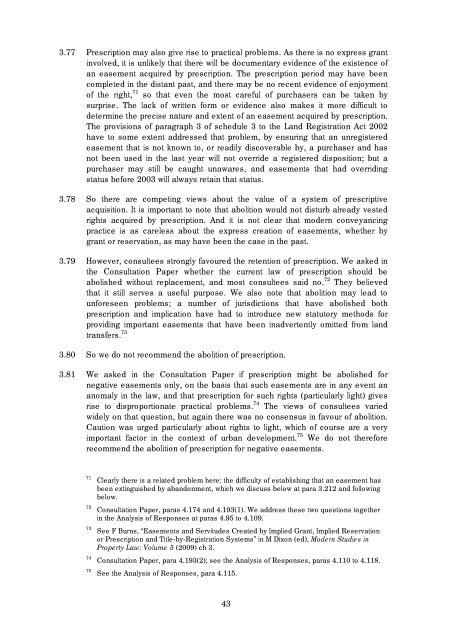Making Land Work: Easements, Covenants and ... - Law Commission
Making Land Work: Easements, Covenants and ... - Law Commission
Making Land Work: Easements, Covenants and ... - Law Commission
You also want an ePaper? Increase the reach of your titles
YUMPU automatically turns print PDFs into web optimized ePapers that Google loves.
3.77 Prescription may also give rise to practical problems. As there is no express grant<br />
involved, it is unlikely that there will be documentary evidence of the existence of<br />
an easement acquired by prescription. The prescription period may have been<br />
completed in the distant past, <strong>and</strong> there may be no recent evidence of enjoyment<br />
of the right, 71 so that even the most careful of purchasers can be taken by<br />
surprise. The lack of written form or evidence also makes it more difficult to<br />
determine the precise nature <strong>and</strong> extent of an easement acquired by prescription.<br />
The provisions of paragraph 3 of schedule 3 to the <strong>L<strong>and</strong></strong> Registration Act 2002<br />
have to some extent addressed that problem, by ensuring that an unregistered<br />
easement that is not known to, or readily discoverable by, a purchaser <strong>and</strong> has<br />
not been used in the last year will not override a registered disposition; but a<br />
purchaser may still be caught unawares, <strong>and</strong> easements that had overriding<br />
status before 2003 will always retain that status.<br />
3.78 So there are competing views about the value of a system of prescriptive<br />
acquisition. It is important to note that abolition would not disturb already vested<br />
rights acquired by prescription. And it is not clear that modern conveyancing<br />
practice is as careless about the express creation of easements, whether by<br />
grant or reservation, as may have been the case in the past.<br />
3.79 However, consultees strongly favoured the retention of prescription. We asked in<br />
the Consultation Paper whether the current law of prescription should be<br />
abolished without replacement, <strong>and</strong> most consultees said no. 72 They believed<br />
that it still serves a useful purpose. We also note that abolition may lead to<br />
unforeseen problems; a number of jurisdictions that have abolished both<br />
prescription <strong>and</strong> implication have had to introduce new statutory methods for<br />
providing important easements that have been inadvertently omitted from l<strong>and</strong><br />
transfers. 73<br />
3.80 So we do not recommend the abolition of prescription.<br />
3.81 We asked in the Consultation Paper if prescription might be abolished for<br />
negative easements only, on the basis that such easements are in any event an<br />
anomaly in the law, <strong>and</strong> that prescription for such rights (particularly light) gives<br />
rise to disproportionate practical problems. 74 The views of consultees varied<br />
widely on that question, but again there was no consensus in favour of abolition.<br />
Caution was urged particularly about rights to light, which of course are a very<br />
important factor in the context of urban development. 75 We do not therefore<br />
recommend the abolition of prescription for negative easements.<br />
71 Clearly there is a related problem here: the difficulty of establishing that an easement has<br />
been extinguished by ab<strong>and</strong>onment, which we discuss below at para 3.212 <strong>and</strong> following<br />
below.<br />
72 Consultation Paper, paras 4.174 <strong>and</strong> 4.193(1). We address these two questions together<br />
in the Analysis of Responses at paras 4.95 to 4.109.<br />
73 See F Burns, “<strong>Easements</strong> <strong>and</strong> Servitudes Created by Implied Grant, Implied Reservation<br />
or Prescription <strong>and</strong> Title-by-Registration Systems” in M Dixon (ed), Modern Studies in<br />
Property <strong>Law</strong>: Volume 5 (2009) ch 3.<br />
74 Consultation Paper, para 4.193(2); see the Analysis of Responses, paras 4.110 to 4.118.<br />
75 See the Analysis of Responses, para 4.115.<br />
43
















